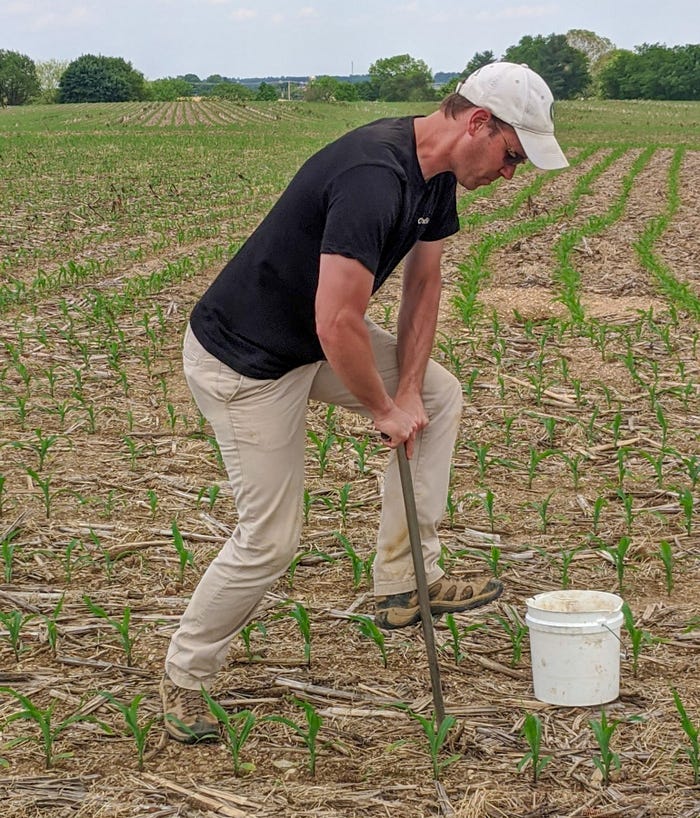
It’s still early in the growing season, but before you know it corn will be needing that extra kick of nitrogen to grow ears.
“I like to point out that almost 25% of the total N uptake that occurs in a plant doesn’t occur until after tasseling,” says Eric Rosenbaum of Rosetree Consulting in Shillington, Pa., adding that growers almost “never see nitrogen deficiencies when corn is 6 inches tall, we never see nitrogen deficiencies when it’s knee high, or even waist high. The majority of the deficiencies that we’re seeing are after tassel and during that early kernel fill period.”
Modeling tools such as Adapt-N and Granular, which can estimate nitrogen needs based on field and weather conditions, have become go-to tools for more accurate nitrogen modeling and getting the right amount of nutrients in the right place at the right time.
Older tools like the Pre-sidedress Nitrogen Test and chlorophyll meter test can also help. But the PSNT, Rosenbaum says, has its limits, especially with commercial fertilizer on fields that have gotten manure in the past.
“I think too much preemerge N will affect the PSNT by overestimating soil nitrogen, resulting in a underapplication of nitrogen,” he says. “So, if somebody is just using manure and is going to come back with some sidedress application, the PSNT works great. But if they’re going to put 15 gallons on with their burndown, that amount of nitrogen just interferes with the accuracy of the PSNT.”
For many farmers, though, the PSNT is still the go-to tool for figuring out how much, if any, nitrogen to sidedress.
When should you do a PSNT test? That depends. Rosenbaum only recommends growers use a PSNT if they’ve applied less than 30 pounds of commercial fertilizer on a field with a history of manure.
 DOWN TO THE CORE: Eric Rosenbaum of Rosetree Consulting takes core samples on a recent farm visit. The PSNT is a useful tool to see if you need a sidedress nitrogen application, but it also has its limits.
DOWN TO THE CORE: Eric Rosenbaum of Rosetree Consulting takes core samples on a recent farm visit. The PSNT is a useful tool to see if you need a sidedress nitrogen application, but it also has its limits.

Testing should be done when the corn is about 12 inches tall. He recommends taking 10 to 15 cores in a field at 12 inches deep, mixing them together and getting them off to a lab quickly. The more tests the better, he says.
Penn State Extension has more information on their test, which costs $6 to perform.
“It won't be long before the corn is 12 inches tall and that's about the time when they want to go in and take a plant sample," he says.
Early season issues
Most of Rosenbaum’s clients are in the south-central and southeast parts of Pennsylvania, the most productive ag area in the state.
Thus far, disease pressure hasn’t been a problem, but early insect pressure has. Wire worms, white grubs and slugs are currently feeding. Even aphids are causing issues in some fields, he says.
“A lot of it has to do with the right conditions for these bugs to flourish, especially on dairy farms that have taken off rye before planting no-till corn,” he says.
For soybeans, early generation beef leaf beetles are currently feeding. He’s also been seeing quite a bit of black cutworm feeding, too.
Growers catch up
Growers in Pennsylvania and the Mid-Atlantic have largely caught up with their corn and soybean plantings while New York growers are still lagging the five-year averages.
Pennsylvania corn is 80% planted, right around the five-year average, but only 36% of it has emerged, well-behind the five-year average of 59%. Soybeans are 56% planted with 30% of plantings emerged, both around average. First-cut alfalfa is 45% finished, which is about average for this time of year. Winter wheat is 80% headed.
Corn is 93% planted in Maryland, ahead of the 84% average, while 55% of the crop has emerged, behind the 69% average for this time of year. Soybeans are 64% planted, ahead of the five-year average of 44%. First-cut hay is 65% complete, just ahead of the 60% average. Winter wheat is 18% coloring, which is right around average.
Delaware growers have planted 83% of the corn crop, just behind the 89% average for this time of year, and 73% of the crop has emerged, which is right around average. Soybeans are 46% planted, ahead of the 38% average, while 25% of the crop has emerged, ahead of the 18% average. First-cut hay is 56% complete, right about average, while 25% of winter wheat is coloring, just ahead of average.
New Jersey growers have planted 62% of corn, behind the five-year average of 76%, while 36% of it has emerged, behind last year’s pace of 48%. Soybeans are 31% planted, just behind the five-year average, while 15% of the crop has emerged.
Corn in New York is 49% planted, well-ahead of last year’s pace of 27% but still behind the five-year average of 60%. The crop is 21% emerged, behind the average of 31%. First-cut alfalfa is 11% complete, well-behind the 29% average for this time of year. Soybeans are 42% planted, ahead of the 40% five-year average and well-ahead of last year’s pace of 14%. But only 10% of the crop has emerged. Winter wheat is 10% headed.
Read more about:
NitrogenAbout the Author(s)
You May Also Like






